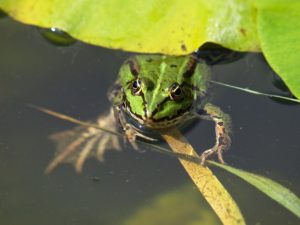All wildlife from tiny critters to large mammals have the same basic needs namely food, water, shelter (to nest young, provide shade, protection from predators) and living space. Building a pond for wildlife can offer so many creatures these basic needs. There are a number of very valuable reasons why should build a pond to attract wildlife into your garden as discussed here:
Why a wildlife pond for your garden?
- Garden ponds have an increased importance to wildlife with some 50% of ponds lost to increasing demands on land for houses, agricultural development, commercial buildings and other urban development
- Important for biodiversity – wildlife ponds support an immense number of plants and animals
- Wildlife ponds can make a huge impact on environmental issues that affect us all such as climate change and pollution, as well as being fantastic for wildlife!
- A source of water to wildlife during dry periods
- Offers an opportunity to watch and learn about the habits and movements of so many fascinating water-loving creatures
- Birds love to bathe in shallow waters
- Plants added around the edges of a pond provide cover for visiting wildlife and a place for frogs to retreat to after the breeding season
- The great variety of aquatic plants added to a pond assists in maintaining healthy water quality. Add submerged oxygenators, floating and marginal aquatic plants for a low maintenance pond
- Provides a most welcome habitat for frogs to breed and spawn. Male frogs will return first to the pond where they were raised and attract the females to them by croaking. Frogs mate in shallow areas of the pond amongst plant growth. The female frog uses plant growth on a shallow shelf area of the pond to support herself during spawning.
- Ponds attract frogs which in turn control the slug population – and save your vegetable garden and flower-beds!
- Newt’s natural behaviour is to wander around looking for a pond to colonise. Building a garden pond will help shorten their journey.

- A rockery or log-pile built alongside a garden pond will offer a place for newts to hide and shelter at the end of the breeding season.
- A wildlife pond planted with aquatic plants such as water forget-me-nots, watercress, water speedwell and flote-grass provides a safe place upon which newts can lay their eggs. Newts will lay their eggs in leaves which have become folded over.
- A pond that has a shallow beached area at one end will provide a bathing area for birds and a source of drinking water for hedgehogs
- Insects need water to survive too!
- An invitation for dragonflies and damselflies to visit during the summer months.
- Keep mosquito numbers down during the summer months by inviting carnivorous damselflies and dragonflies into your garden.
- Dragonflies and damselflies can only breed in unpolluted water rich in oxygen. They are, therefore a good indicator of the presence of healthy, clean water conditions
- A pond is likely to attract toads to your garden. They in turn will control insect numbers. Toads thrive on insects and therefore are an alternative to using gardening pesticides to protect your vegetables. Toads are more likely to be attracted into gardens that also offer moist environments under rocks, logs and trees.
- Attract toads to also eat unwelcome pests such as slugs, snails and mosquitoes
- Any size pond is important to wildlife. A large pond, however is more likely to attract the presence of waterfowl, including mallard ducks, moorhens and coots
- Provides a home for rare species like water voles
- Offers an opportunity to plant aquatic plants for a greater variety of flora in your gardens micro-environment
- Encourages a greater awareness of caring for our environment. Invest in a rainwater butt so you can top up your pond with clean rainwater which is beneficially lower in nutrients
- So that wildlife continues to be looked after for future generations
- Most important feature of an organically maintained garden
Other articles on building a pond for wildlife
How to attract wildlife to your pond
Get funky attracting wildlife to your pond and garden
| “Of all the habitats you can create to help wildlife, a pond is probably the most effective” RSPB | ||





